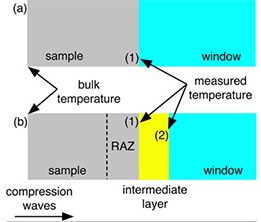Nevada National Security Site (NNSS) Special Technologies Laboratory (STL) Scientists Gerald Stevens, Brandon LaLone and Lynn Veeser are honored in the July 2020 Journal of Applied Physics Editor’s Pick for their research article titled, “Thermal interfaces in dynamic compression experiments.”
The collaborative research, with experiments conducted at NNSS’ STL, located in Santa Barbara, California, with Los Alamos National Laboratory and Sandia National Laboratories, both based in New Mexico, examines the challenges of interpreting dynamic temperature measurements. While scientists have established techniques to measure temperature from a radiant surface, that particular surface can often be the interface between different materials. Understanding the details of resultant temperature profiles is key to understanding the equation of state of the shocked sample under investigation. The published data represents two years of work.
“Our team felt this topic needed to be addressed in publication because many people are now working on dynamic temperature measurements,” said Stevens, who manages the STL physics team. “However, few studies focus on and understand the minutiae and address how those details drive our interpretation of the results — and this is one of them. You develop intuition as a scientist in your work when it contributes something new and worthy of publication. It’s a huge effort to write one of these papers.”
Submitting to an established and reputable journal can be an intricate process. Once the team felt it had enough data and modeling to be complete, the initial article was sent for a peer review, which allows the reviewer to ask for clarifications or challenge the content. The process was completed in about eight weeks. Stevens noted that the NNSS’ Normal Operations with Maximized Telework posture has afforded scientists time to reanalyze data and work on articles from recent research, which will likely result in a number of NNSS publications this year.
Now available to the public, Stevens hopes “Thermal interfaces in dynamic compression experiments” will prove useful for colleagues within the NNSA enterprise, organizations like the Atomic Weapons Establishment, which provides nuclear defense for the United Kingdom, as well as academic institutions with temperature diagnostics programs, such as Caltech. As one publication is complete, the next is already underway. The team is currently authoring a paper that studies dynamic temperature measurements of Cerium. Encompassing more than two years of experimental research, Stevens noted the data that will be submitted for publication shows the team’s method to be the most precise temperature measurement technique.
“It’s one of the things we do that lends credibility to the NNSS,” said Stevens. “If you want to be known as a science and tech organization, then the proof is in the publications. Publications broadcast your work and your capabilities to the community at large.”

